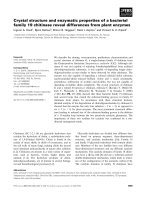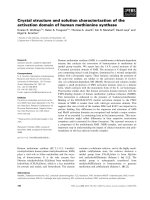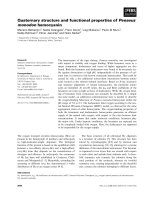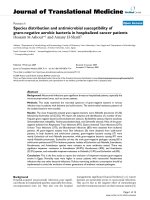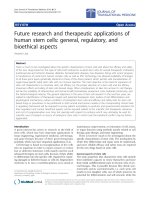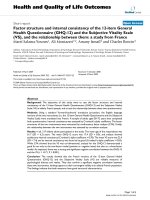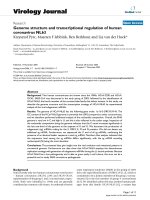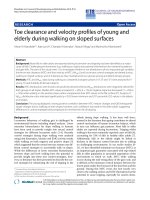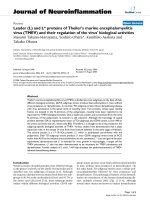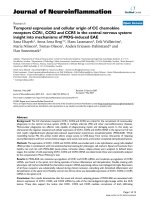báo cáo hóa học:" Crystal structure and electrical properties of bismuth sodium titanate zirconate ceramics" pdf
Bạn đang xem bản rút gọn của tài liệu. Xem và tải ngay bản đầy đủ của tài liệu tại đây (845.73 KB, 5 trang )
NANO EXPRESS Open Access
Crystal structure and electrical properties of
bismuth sodium titanate zirconate ceramics
Ampika Rachakom
1
, Panupong Jaiban
1
, Sukanda Jiansirisomboon
1,2
and Anucha Watcharapasorn
1,2*
Abstract
Lead-free bismuth sodium titanate zirconate (Bi
0.5
Na
0.5
Ti
1-x
Zr
x
O
3
where x = 0.20, 0.35, 0.40, 0.45, 0.60, and 0.80 mole
fraction) [BNTZ] ceramics were successfully prepared using the conventional mixed-oxide method. The samples
were sintered for 2 h at temperatures lower than 1,000°C. The density of the BNTZ samples was at least 95% of the
theoretical values. The scanning electron microscopy micrographs showed that small grains were embedded
between large grains, causing a relatively wide grain size distribution. The density and grain size increased with
increasing Zr concentration. A peak shift in X-ray diffraction patterns as well as the disappearance of several hkl
reflections indicated some significant crystal-structure changes in these materials. Preliminary crystal-struct ure
analysis indicated the existence of phase transition from a rhombohedral to an orthorhombic structure. The
dielectric and ferroelectric properties were also found to correlate well with the observed phase transition.
Keywords: ceramics, X-ray diffraction, dielectric properties, ferroelectricity
Background
Lead-based PbTiO
3
-PbZrO
3
solid solutions have domi-
nated the market of actuator and sensor materials due to
their excellent ferroelectric and piezoelectric properties.
In particular, a compositional ratio of Zr/Ti of around
52/48 showed the morphotropic phase boundary between
a tetragonal and a rhombohedral phase, where enhanced
polarizability and optimum domain orientation were
observed [1-6]. However, PbO loss during high-tempera-
ture processes is considered to be environmental pollu-
tion with additional problems of recycling and waste
disposal. Therefore, researchers have attempted to
develop new lead-free smart materials in order to replace
the lead-based ones [7]. BaTiO
3
is one example of the
most commonly used lead-free material for capacitors
and actuators due to its inherent ferroelectric nature.
However, its main disadvant age is the narrow working
temperature; therefore, the use of a BaTiO
3
-BaZrO
3
solid
solution with the addition of Zr up to 30% mole was
investigated [8-10]. The materials were found to exhibit a
composition-induced phase transition from normal to
relaxor ferroelectric with a higher dielectric constant
than both PZT and BaTiO
3
. This allowed the materials
to be used over a broader temperature range. Following
these studies, this paper was aimed to study Bi
0.5
Na
0.5-
TiO
3
-Bi
0.5
Na
0.5
ZrO
3
solid solutions with the addition of
a Zr concentration from 0.20, 0.35, 0.40, 0.45, 0.60, and
0.80 mole fraction. The relationship between the phase,
crystal structure, and electrical properties is investigated
and discussed.
Methods
Bi
0.5
Na
0.5
Ti
1-x
Zr
x
O
3
compositions were prepared using
the mixed-oxide method incorporat ing Bi
2
O
3
(> 98%,
Fluka, Sigma-Aldrich Corporation, St. Louis, MO, USA),
Na
2
CO
3
(99.5%, Carlo Erba Reagenti SpA, Rodano, Italy),
TiO
2
(> 99%, Riedel de Haën, Sigma-Aldrich Corpora-
tion, St. Louis, MO, USA), and ZrO
2
(> 99%, Riedel de
Haën) in stoichiometr ic proportions. The mixed pow ders
were ball milled in ethanol for 24 h using zirconia milling
media and calcined at 800°C for 2 h. The calcined
Bi
0.5
Na
0.5
Ti
1-x
Zr
x
O
3
powders were then ball milled again
for 6 h and uniaxially pressed at a pressure of 5.5 MPa
with a few drops of 3 wt.% polyvinyl alcohol to bind it
into disks of 10-mm diameter and 1- to 1.5-mm thick-
ness. The disks were the sintered at 900°C for 2 h, except
for the sample with 0.20 mole fraction Zr which was sin-
tered at 950°C for 2 h, in air. The X-ray diffractometer
* Correspondence:
1
Department of Physics and Materials Science, Faculty of Science, Chiang
Mai University, Chiang Mai, 50200, Thailand
Full list of author information is available at the end of the article
Rachakom et al. Nanoscale Research Letters 2012, 7:57
/>© 2012 Rachakom et al; licensee Springer. This is an Open Access article distributed under the terms of the Creative Commons
Attribution License (http://creati vecommons.org/licenses/by/2.0), w hich permits unrestricted use , distribution, and reproduction in
any me dium, provided the original work is properly cited.
(Philip Model X-pert, PANalytical B.V., Almelo, The
Netherlands) with CuKa radiation was used to investi-
gate the phase and crystal structure of the sintered cera-
mics. The preliminary crystal structure details were
calculated using the Powder Cell program [11], which is
based on the X-ray diffraction pattern of lead-free bis-
muth sodium titanate zirconate (Bi
0.5
Na
0.5
Ti
1-x
Zr
x
O
3
where x = 0.20, 0.35, 0.40, 0.45, 0.60, and 0.80 mole frac-
tion) [BNTZ] ceramics. The bulk densities of the sintered
ceramics were measured using Archimedes’ method. The
theoretical density w as approximated from the unit cell
size and its constituent ions. Scanning electron micro-
scopy [SEM] (JEOL JSM-6335F, JEOL Ltd., Akishima,
Tokyo, Japan) was used to observe the microstructure of
the ceramics. To prepare the SEM samples, they were
well-polished and thermally etched for 15 min at 750°C.
The average grain size was then evaluated from these
SEM images. The room temperature dielectric constant
[ε
r
] and dielectric loss [tan δ] were measured with an
LCR meter (LF Impedance Analyzer 4292A, Agilent
Technologies Inc., Santa Clara, CA, USA), but the ferro-
electric hysteresis loops were measured in a silicone oil
bath using a modified Sawyer-Tower circuit.
Results and discussion
X-ray diffraction patterns of Bi
0.5
Na
0.5
Ti
1-x
Zr
x
O
3
cera-
mics where x = 0.20, 0.35, 0.40, 0.45, 0.60, and 0.80 mole
fraction are shown in Figure 1. The BNTZ phase could
be matched with pure BNT (ICSD file no. 280983) for
the rhombohedral space group R3c [12,13]. With the pre-
sence of Zr, all reflection peaks systematically shifted to
angles lower than 2
θ
·
. This observation suggested that
the Zr
4+
-ion substitution into the Ti
4+
site led to an
enlargement of the unit cell [9,10] which corresponded
tothefactthattheionicradiusofZr
4+
( r
Zr
4+
=0.72Å
[14]) was larger than that of Ti
4+
(r
Ti
4+
= 0.605 Å [14]).
Accompanying the shift, intensities of some diffraction
peaks such as (012) and (202) were reduced, indicating
that lattice distortion alongside unit cell expansion has
occurred. The refinement of the X-ray diffraction
Figure 1 X-ray diffraction patterns of Bi
0.5
Na
0.5
Ti
1-x
Zr
x
O
3
ceramics. Where x = 0.20, 0.35, 0.40, 0.45, 0.60, and 0.80 mole fraction.
Rachakom et al. Nanoscale Research Letters 2012, 7:57
/>Page 2 of 5
patterns was carried out, and the results are listed in
Table 1. The refined patterns for the Zr compositions
equal to 0.2 and 0.8 are also shown in Figure 2. From
these data, BNTZ ceramics containi ng Zr from 0.2 to 0.6
possessed a rhombohedral structure with increased lat-
tice parameters. The increase in the value of the interax-
ial angle caused the structure to be close to cubic, which
resulted in the disappearance of certain reflections. For
Zr = 0.8, Figures 1 and 2 showe d an apparent splitting of
the (104) and (300) peaks in the original rhombohedral
structure. Based on refinement results, the structure was
orthorhombic having the lattice parameters shown in
Table 1. This finding was somewhat in partial agreement
with the ort horhombic structure previously obtained for
Bi
0.5
Na
0.5
ZrO
3
[15]. Hence, for this BNTZ solid solution
ceramic system, the structure changed from rhombohe-
dral to orthorhombic when the Zr concentration
exceeded 0.6 mole fraction. The exact phase-transition
composition is currently being investigated.
All BNTZ ceramics had experimental density values in
the range of 5.8 to 6.1 g/cm
3
as shown in Table 1 which
corresponded to the relative densities of around 95% of
the theoretical densities. For the 0.20 mole fraction of Zr,
the sample was sintered at 950°C for 2 h due to the influ-
ence of a high Ti concentration [16,17]. As the amount
of Zr increased, the sintering temperature could be low-
ered to 900°C. This seemed to be a typical behavior of
solid solutions whose melting points might be lowered by
adding Zr as a deducted form of the lattice expansion.
The difference in sintering behavior could also b e
observed from the microstructure of BNTZ ceramics; all
samples were dense with well-defined grains (Figure 3).
The ceramic containing Zr = 0.2 possessed an average
grain size of about 0.8 μm, whereas the presence of Zr
ions generally caused the grain size to increase. The
enhanced ability for ionic diffusion in BNTZ ceramics
seemed to support the possible lowering of the melting
point of these solid solutions.
The ε
r
and tan
δ
·
of Bi
0.5
Na
0.5
Ti
1-x
Zr
x
O
3
ceramics, at
the frequency of 100 kHz, are tabulated in Table 1. In
general, increasing Zr concentration in BNTZ ceramics
caused a gradual decrease in dielectric constant with a
slight decrease in dielectric loss. This behavior was in
agreement with other systems with isovalent additives
Table 1 Relationships between crystal structure and electrical properties of BNTZ ceramics
Bi
0.5
Na
0.5
Ti
1-x
Zr
x
O
3
(mole fraction)
Lattice parameter/distortions Relative density Dielectric constant (ε
r
)
at 100 kHz
tan
δ
·
a, b, c (Å) a (°)
0.20 3.9222 89.8600 94.7 445.8105 0.0878
0.35 3.9556 89.8675 97.7 453.3421 0.0811
0.40 3.9602 89.8713 96.8 320.9603 0.0706
0.45 3.9721 89.8719 96.1 313.1384 0.0627
0.60 3.9879 89.9247 96.8 239.9664 0.0668
0.80 a = 5.9663
b = 8.0883
c = 5.6664
90.000 97.9 196.2317 0.0439
Figure 2 Refinement of Bi
0.5
Na
0.5
Ti
1-x
Zr
x
O
3
ceramics. The refinement at (a)0.20molefractionand(b)0.80molefractionshoweda
rhombohedral phase and an orthorhombic phase, respectively.
Rachakom et al. Nanoscale Research Letters 2012, 7:57
/>Page 3 of 5
[2]. In addition, the replacement of larger Zr ions may
also cause the dipoles to be poorly induced due to limited
ionic movement. This decreasing trend was observed
through the sample with a composition of Zr = 0.8,
whose structure was orthorhombic. It seemed that the
effect of ionic size and limited ionic movement in the
perovskite structure of this compound had a greater
influence on the dielectric properties than the change in
the crystal structure in their unit-all dimentions.
Figure 4a, b illustrates the polarization-electric field [P-
E] hysteresis loops and the breakdown field strengths of
BNTZ ceramics, respectively. The hysteresis loops were
obtained at the maximum applied electric field of 20 kV/
cm and a frequency of 50 Hz. The shape of the P-E loops
varied greatly with the ceramic composition. Up to Zr =
0.45 mole fraction, the loops showed an ellipse shape due
to the vertical deflection electric field with partial dielec-
tric displacement and partly due to conduction [1]. Lim-
ited domain reorientation might also be the cause of
poor hysteresis loops for these compositions. For samples
with Zr = 0.6 and 0.8, the loops showed higher values of
remanent polarization though they were still unsaturated.
Figure 3 SEM image of Bi
0.5
Na
0.5
Ti
1-x
Zr
x
O
3
ceramics. Where x = 0.20, 0.35, 0.40, 0.45, 0.60, and 0.80 mole fraction.
Figure 4 P-E hysteresis loops (a) and the breakdown field (b) of Bi
0.5
Na
0.5
Ti
1-x
Zr
x
O
3
ceramics.Wherex = 0.20, 0.35, 0.40, 0.45, 0.60, and
0.80 mole fraction.
Rachakom et al. Nanoscale Research Letters 2012, 7:57
/>Page 4 of 5
This seemed to show the approximate transition point
between the rhombohedral and orthorhombic structures .
This was supported by an increase in the breakdown field
strength for the Zr = 0.8 composition, which was partly
due to the effect of a different crystal structure in this
series of mate rials. Hence, this study showed t hat the
observed dielectric and ferroelectric properties of BNTZ
ceramics largely depended on c ompositional and crystal
structure changes. Optimization of these properties could
be achieved by fine-tuning the composition for specific
applications.
Conclusions
Lead-free Bi
0.5
Na
0.5
Ti
1-x
Zr
x
O
3
(where x = 0.20, 0.35,
0.40, 0.45, 0.60, and 0.80 mole fraction ) ceramics were
successfully fabricated. X-ray diffraction patterns showed
phase transition from rhombohedral to an orthorhombic
structure. The addition of Zr concentration caused lat-
tice expansion in agreement with ionic size considera-
tion. All ceramic samples were dense with well-defined
grain structures. The dielectric constant was found to
decrease with increasing Zr content due to the larger-
sized ionic substitution that limited dipole movement.
Ferroelectric properties also showed compositional
dependence due to the variation in domain reorientation
ability. This study showed that electrical properties of
BNTZ ceramics could be further improved by fine-tun-
ing their composition for certain applications.
Acknowledgements
This work was financially supported by the Nation Metal and Materials
Technology Center (MTEC), Nation Science and Technology Development
Agency (NSTDA), Thailand Research Fund (TRF), and the National Research
University Project under Thailand’s Office of the Higher Education
Commission (OHEC). The Faculty of Science and the Graduate School,
Chiang Mai University is also acknowledged. Ms. Ampika Rachakom would
like to thank the Commission on Higher Education for their support through
a grant fund under the program Strategic Scholarships for Frontier Research
Network for the Ph.D. Program Thai Doctoral degree for this research.
Author details
1
Department of Physics and Materials Science, Faculty of Science, Chiang
Mai University, Chiang Mai, 50200, Thailand
2
Materials Science Research
Center, Faculty of Science, Chiang Mai University, Chiang Mai, 50200,
Thailand
Authors’ contributions
AR carried out the bismuth sodium titanate zirconate experiment and
analysis and drafted the manuscript. PJ participated as the assistant for the
research experiment. AW and SJ participated in the conception and design
of the study and revised the manuscript for important intellectual content.
All authors read and approved the final manuscript.
Competing interests
The authors declare that they have no competing interests.
Received: 8 September 2011 Accepted: 5 January 2012
Published: 5 January 2012
References
1. Jaffe B, Cook WR, Jaffe H: Piezoelectric Ceramics London: Academic Press;
1971.
2. Haertling GH: Ferroelectric ceramics: history and technology. J Am Ceram
1999, 82:797.
3. Moulson AJ, Herbert JM: Electroceramics: Materials, Properties, Applications
Chichester: Wiley; 2003.
4. Shrout TR, Zhang SJ: Lead-free piezoelectric ceramics: alternatives for
PZT? J Electroceram 2007, 19:111-124.
5. Cross LE, Newnham RE: History of ferroelectrics. J Am Ceram 1987,
11:289-305.
6. Panda PK: Review: environmental friendly lead-free piezoelectric
materials. J Mater Sci 2009, 44:5049-5062.
7. Takenaka T, Nagata H, Hiruma Y, Yoshii Y, Matumono K: Lead-free
piezoelectric ceramics based on perovskite structures. 2007, 19:259-265.
8. Yu Z, Ang C, Guo R, Bhalla AS: Dielectric properties of Ba(Ti
1-x
Zr
x
)O
3
. Mater
Lett 2007, 61:326-329.
9. Yu Z, Ang C, Guo R, Bhalla AS: Piezoelectric and strain properties of Ba
(Ti
1-x
,Zr
x
)O
3
ceramics. J Appl Phys 2002, 92:1489-1493.
10. Tang XG, Chew K-H, Chan HLW: Diffuse phase transition and dielectric
tenability of Ba(Zr
y
,Ti
1-y
)O
3
relaxor ferroelectric ceramics. Acta Materialia
2004, 52:5177-5183.
11. Kraus W, Nolze G: POWDER CELL- a program for the representation and
manipulation of crystal structures and calculation of the resulting X-ray
powder patterns. J Appl Cryst 1996, 29:301-303.
12. Jones GO, Thomas PA: Investigation of the structure and phase transition
in the novel A-site substituted distorted perovskite compound
Na
0.5
Bi
0.5
TiO
3
. Acta Cryst 2002, B58:168-178.
13. Jones GO, Thomas PA: The tetragonal phase of Na
0.5
Bi
0.5
TiO
3
- a new
variant of the perovskite structure. Acta Crysta 2000, B58:426-430.
14. Shannon RD: Revised effective ionic radii and systematic studies of
interatomic distances in halides and chalcogenides. Acta Cryst 1976,
A32:751-767.
15. Lily Kumari K, Prasad K, Yadav KL: Dielectric and impedance study of lead-
free ceramic: (Na
0.5
Bi
0.5
)ZrO
3
. J Mater Sci 2007, 42:6252-6259.
16. Watcharapasorn A, Jiansirisomboon S, Tunkarisi T: Effects of dysprosium
oxide addition in bismuth sodium titanate ceramics. J Electroceram 2008,
21:613-616.
17. Watcharapasorn A, Jiansirisomboon S: Dielectric and piezoelectric
properties of zirconium-doped bismuth sodium titanate ceramics. Adv
Mater Res 2008, 55:133-136.
doi:10.1186/1556-276X-7-57
Cite this article as: Rachakom et al.: Crystal structure and electrical
properties of bismuth sodium titanate zirconate ceramics. Nanoscale
Research Letters 2012 7:57.
Submit your manuscript to a
journal and benefi t from:
7 Convenient online submission
7 Rigorous peer review
7 Immediate publication on acceptance
7 Open access: articles freely available online
7 High visibility within the fi eld
7 Retaining the copyright to your article
Submit your next manuscript at 7 springeropen.com
Rachakom et al. Nanoscale Research Letters 2012, 7:57
/>Page 5 of 5
